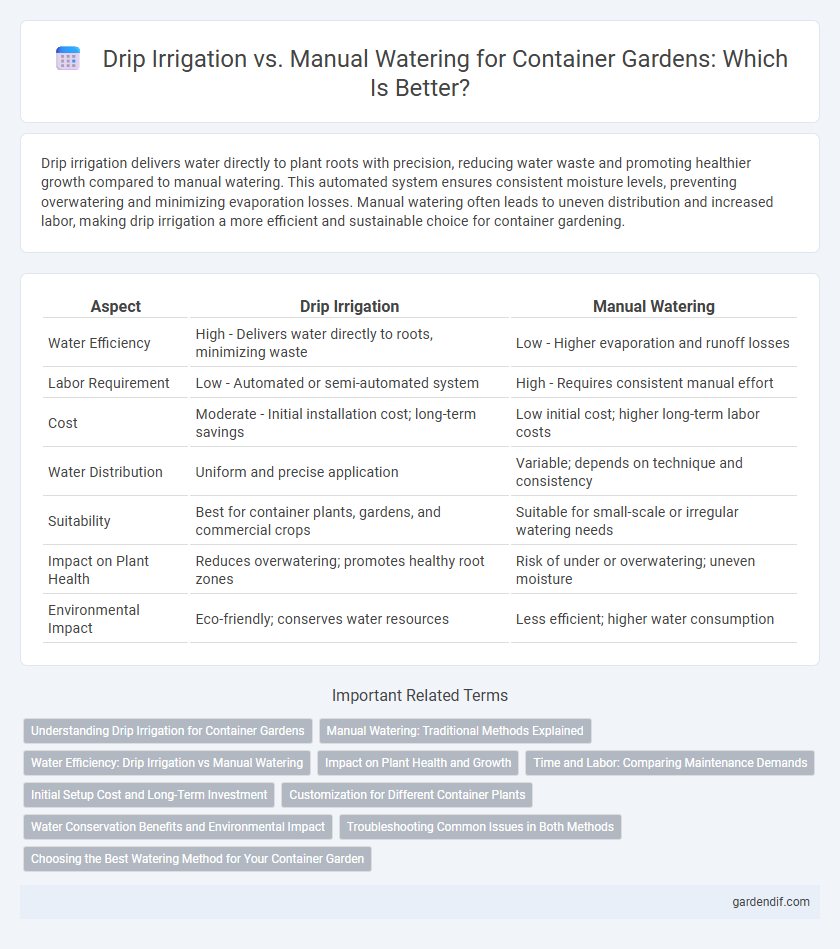
Drip irrigation vs manual watering Illustration
Drip irrigation delivers water directly to plant roots with precision, reducing water waste and promoting healthier growth compared to manual watering. This automated system ensures consistent moisture levels, preventing overwatering and minimizing evaporation losses. Manual watering often leads to uneven distribution and increased labor, making drip irrigation a more efficient and sustainable choice for container gardening.
Table of Comparison
| Aspect | Drip Irrigation | Manual Watering |
|---|---|---|
| Water Efficiency | High - Delivers water directly to roots, minimizing waste | Low - Higher evaporation and runoff losses |
| Labor Requirement | Low - Automated or semi-automated system | High - Requires consistent manual effort |
| Cost | Moderate - Initial installation cost; long-term savings | Low initial cost; higher long-term labor costs |
| Water Distribution | Uniform and precise application | Variable; depends on technique and consistency |
| Suitability | Best for container plants, gardens, and commercial crops | Suitable for small-scale or irregular watering needs |
| Impact on Plant Health | Reduces overwatering; promotes healthy root zones | Risk of under or overwatering; uneven moisture |
| Environmental Impact | Eco-friendly; conserves water resources | Less efficient; higher water consumption |
Understanding Drip Irrigation for Container Gardens
Drip irrigation delivers water directly to the root zone of container plants, minimizing evaporation and runoff while ensuring consistent moisture levels. This method improves water efficiency by gradually releasing water, which reduces the risk of overwatering and nutrient leaching compared to manual watering. In container gardens, drip irrigation systems can be customized with emitters and timers to meet specific plant water requirements, promoting healthier growth and conserving water.
Manual Watering: Traditional Methods Explained
Manual watering involves using tools such as watering cans or hoses to deliver water directly to the base of container plants, allowing for precise control over the amount and timing of water application. This traditional method requires consistent attention, as overwatering or underwatering can easily occur without careful monitoring of soil moisture. While labor-intensive compared to automated systems, manual watering remains a cost-effective and accessible technique for gardeners managing container plants in various environments.
Water Efficiency: Drip Irrigation vs Manual Watering
Drip irrigation delivers water directly to the root zone, reducing evaporation and runoff, which significantly enhances water efficiency compared to manual watering methods. Manual watering often leads to overwatering or uneven distribution, wasting substantial amounts of water and increasing plant stress. Studies show drip irrigation can reduce water usage by up to 50% while promoting healthier plant growth and conserving resources in container gardening.
Impact on Plant Health and Growth
Drip irrigation delivers water directly to the plant roots, promoting consistent moisture levels and reducing water stress, which enhances plant health and growth rate compared to manual watering. Manual watering often leads to uneven water distribution and potential over- or under-watering, increasing the risk of root rot or dehydration. Efficient water management through drip systems supports stronger root development and higher yields in container-grown plants.
Time and Labor: Comparing Maintenance Demands
Drip irrigation significantly reduces time and labor compared to manual watering by automating water delivery directly to plant roots. This method minimizes the need for daily attention and manual effort, allowing more efficient use of maintenance resources. In contrast, manual watering requires constant monitoring and physical labor, increasing labor costs and time investment.
Initial Setup Cost and Long-Term Investment
Drip irrigation systems require a higher initial setup cost due to the need for tubing, emitters, and connectors, but offer significant water savings and efficiency over time. Manual watering involves minimal upfront expenses but demands continuous labor and can lead to inconsistent water distribution. Investing in drip irrigation ultimately reduces water wastage and maintenance efforts, providing better long-term value for container gardening.
Customization for Different Container Plants
Drip irrigation offers precise customization tailored to the specific water needs of various container plants, allowing adjustable flow rates and targeted delivery that prevent overwatering or underwatering. Manual watering relies heavily on user judgment, making it challenging to maintain consistent moisture levels across different plant species and container sizes. Automated drip systems enhance plant health by adapting to unique root zones and moisture requirements, optimizing growth conditions efficiently.
Water Conservation Benefits and Environmental Impact
Drip irrigation delivers water directly to the plant roots with minimal evaporation, reducing water usage by up to 50% compared to manual watering. This method lowers runoff and soil erosion, enhancing water conservation and promoting sustainable container gardening. By minimizing water waste and nutrient leaching, drip irrigation significantly reduces the environmental impact associated with traditional manual watering techniques.
Troubleshooting Common Issues in Both Methods
Drip irrigation systems often face clogging due to mineral buildup or debris in emitters, requiring regular filter cleaning and system flushing to maintain optimal flow rates. Manual watering can lead to inconsistent moisture levels and root diseases if overwatering or underwatering occurs, necessitating careful monitoring of soil moisture and plant health. Both methods benefit from routine inspection and adjustment to prevent water waste and promote efficient plant hydration in container gardening.
Choosing the Best Watering Method for Your Container Garden
Drip irrigation delivers water directly to the root zone of container plants, improving water efficiency by up to 50% compared to manual watering, which can cause uneven moisture distribution and increase evaporation. This method reduces labor and conserves water, making it ideal for consistent watering schedules and ensuring optimal plant health in confined containers. Selecting drip irrigation over manual watering supports sustainable gardening practices and enhances growth by maintaining precise soil moisture levels.
Drip irrigation vs manual watering Infographic

 gardendif.com
gardendif.com